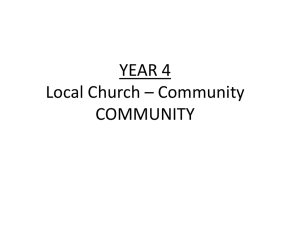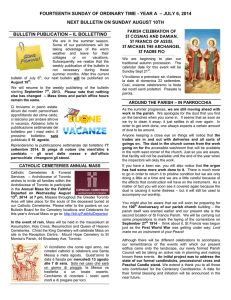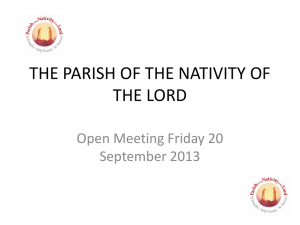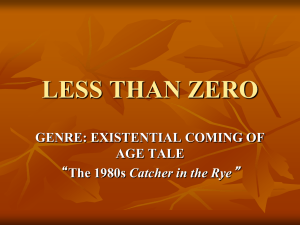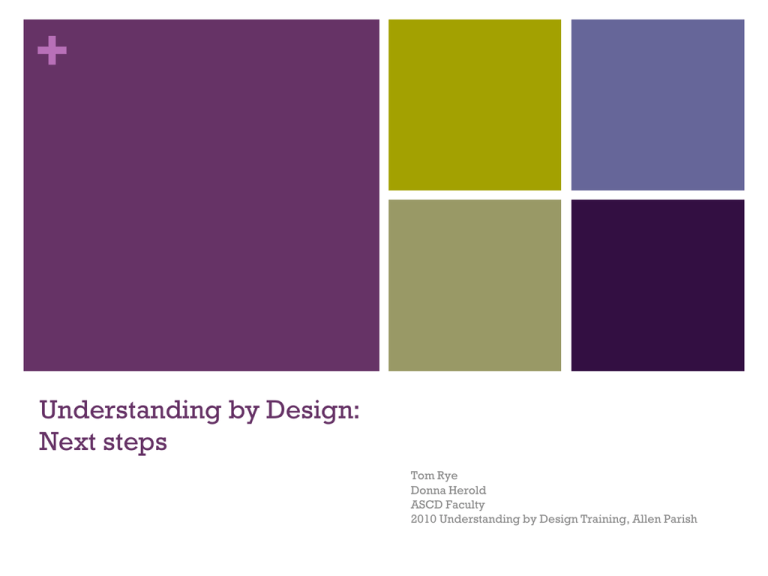
+
Understanding by Design:
Next steps
Tom Rye
Donna Herold
ASCD Faculty
2010 Understanding by Design Training, Allen Parish
1
+
Think of a successful learning
experience. Identify three
characteristics that made it successful:
1.
2.
3.
+
3
Our Outcomes
•
Explore backward design principles and common
misunderstandings about design;
•
Identify desired results for unit of study and draft a complete
unit to include an assessment and learning plan;
•
Review unit of study applying design standards
•
Strategize about how to collaboratively develop multiple
units, courses, and programs as you move forward
ASCD Allen Parish 2010; Rye and Herold
+
4
Tasks:
Design a unit for a period of instruction between 1-6 weeks.
Review units by applying design standards and offering
feedback to improve design.
Explore what an Understanding by Design classroom looks
like.
ASCD Allen Parish 2010; Rye and Herold
Essential Questions:
Why Understanding by Design? Why 21st Century Skills?
What strategies are there for evaluating and revising existing
UbD units?
What is a performance task?
To what extent can we truly implement a performance task into
every unit of instruction?
How can we assess/grade performance tasks reliably and
practically?
What does a UbD classroom actually look like?
How do we continue to move forward professionally?
Why are we here?
What do you want
your students to
remember about
your class ten,
twenty years from
now?
ASCD Allen Parish 2010; Rye and Herold
6
+What is Understanding?
Understanding
Understanding
Big ideas make meaning of the learning and permit transfer
Transfer is the key evidence of understanding (or lack of it)
Good design
best done “backward” from the desired understanding
Given the understanding we seek, we ask: what follows
for assessment and for student learning?
ASCD Allen Parish 2010; Rye and Herold
7
+ Designing for understanding:
“Understanding is never
a passive possession of
information or mere
automaticity of skill, but
the capacity to act
wisely, decisively and
effectively.”
--
ASCD Allen Parish 2010; Rye and Herold
Schooling by Design (2007)
8
+ What is ‘understanding’?
- really ‘getting it’?
What does understanding as a goal require of
‘Designs’ - our planning?
Learning and teaching activities?
Assessment and feedback to learners?
How
do we achieve understanding
by design vs. ‘good fortune’?
ASCD Allen Parish 2010; Rye and Herold
+
Three stages of backward design
1. Identify desired results
2. Determine acceptable evidence
3. Plan learning experiences
& instruction
ASCD Allen Parish 2010; Rye and Herold
10
+
Three stages of backward design
1. What should students be able to
DO with their learning?
2. What IS valid evidence of ability to
meet the long-term transfer goal?
3. What learning experiences
& instruction do students need
to get there?
ASCD Allen Parish 2010; Rye and Herold
11
+
12
Typically:
1. Identify content to be acquired
Without checking for
alignment
2. Brainstorm lessons to teach the content
Without checking for
alignment
3. Create an assessment
to
judge if students learned the content
ASCD Allen Parish 2010; Rye and Herold
+
13
UbD design template
ASCD Allen Parish 2010; Rye and Herold
+
Three stages of backward design
1. Identify desired results
2. Determine acceptable evidence
3. Plan learning experiences
& instruction
ASCD Allen Parish 2010; Rye and Herold
14
+
15
Stage 1:Desired results
Stage 1 - Desired Results
Established Goals
•Excerpted from program level documents
•Demonstrates how unit will embody system expectations
Enduring Understanding(s):
•Insights students earn that
will transfer to new learning
Essential Question(s):
•Inquiry students pursue to
earn insights and develop
proficiency
Students will know and be able to do:
•Content priorities for the unit / course / subject
•Students will be accountable to demonstrate in their work
•Key vocabulary concepts
ASCD Allen Parish 2010; Rye and Herold
+
16
What the research says
“Research on expertise suggests that a
superficial coverage of many topics in the
domain may be a poor way to help students
develop the competencies that will prepare
them for future learning and work.”
-- Bransford, How People Learn
ASCD Allen Parish 2010; Rye and Herold
+
From the Agriculture Age
to the Conceptual Age
Affluence,
Technology,
Globalization
Agricultural Age
(farmers)
18th century
ASCD Allen Parish 2010; Rye and Herold
Industrial
Age
(factory
workers)
19th century
Information
Age
(knowledge
worker)
20th century
Conceptual
Age
(creators and
empathizers)
21st century
+
Are we developing. . .
communicators . . .
leaders . . .
creators . . .
critical thinkers . . .
self-directed workers?
ASCD Allen Parish 2010; Rye and Herold
+
Really Ready to Work?
ASCD Allen Parish 2010; Rye and Herold
+
Partnership for 21st Century
Core Themes and skills
THEMES:
Global
Awareness
Financial, economic, business, and entrepreneurial
literacy
Civic literacy,
Health and environmental literacy
SKILLS:
Creativity
and Innovation
Information, Media, and Technology Skills
Life and Career Skills
ASCD Allen Parish 2010; Rye and Herold
+
21st Century skills / themes checklist
+
22
Design Standards for
Enduring Understandings
Big
ideas at the heart of the
discipline
Requires “uncoverage”
Lasting
value beyond the classroom
Measurable
ASCD Allen Parish 2010; Rye and Herold
+Establishing Priorities: From “Big Ideas”
to Enduring Understandings
Worth being
familiar with
Important
to
know & do
Big ideas &
Enduring
Understandings
ASCD Allen Parish 2010; Rye and Herold
Nice to know
Foundational
knowledge & skill
“Big ideas”
worth
exploring and
understanding
in depth
+
40-40-40
A timeline detailing the
early history of the Internet
How to evaluate
the credibility of
Internet sources
Emerging
technologies have the
power to change the
way we understand
our world
ASCD Allen Parish 2010; Rye and Herold
Nice to know
Foundational
knowledge & skill
“Big ideas”
worth
exploring and
understanding
in depth
+
Key protests of
Civil Rights
Movement
Analyze effects of
landmark U.S. Supreme Court
decisions such as Brown v.
Board of Education
Conflict creates
change
ASCD Allen Parish 2010; Rye and Herold
Nice to know
Foundational
knowledge & skill
“Big ideas”
worth
exploring and
understanding
in depth
+
Enduring Understandings for 21st
Century Skills
In
pairs, write an enduring understanding derived
from the 21st century skills/themes
+
27
Sample enduring understandings
Social Studies
A union is only as strong as its citizens belief in it and
each other.
The government structure reflects the amount of faith the
leaders have in its people.
We have become more democratic over time.
English
Youth cannot always know what is right because of
inexperience.
You are judged by the rules you follow and the rules you
break.
ASCD Allen Parish 2010; Rye and Herold
+
28
Sample enduring understandings
Physical Education/Health
Knowing
the rules can create opportunities.
A
team is more than a collection of
individuals.
Risk-taking
has both expected and
unexpected consequences.
ASCD Allen Parish 2010; Rye and Herold
+
29
Sample enduring understandings
Art
The context in which a piece is created impacts the
audience’s perception of the piece.
Experience and opportunities provide inspiration for
further pursuits.
FACS
Pursuing a career path requires structured long-term
planning and willingness to deviate from those plans to
take risks.
You are judged by the rules you follow and the rules you
break.
ASCD Allen Parish 2010; Rye and Herold
+
30
Sample enduring understandings
Computers/Business Education
A
good planner knows why and when to make
adjustments.
Success
and failures are measured in every area of
business.
Audience
and purpose influence the choice, use and
presentation of language.
Satisfying
a customer at any cost is not always good
for business.
ASCD Allen Parish 2010; Rye and Herold
+
31
Sample enduring understandings
Environmental Science:
Citizens have a responsibility to voice their opinions about important
issues in articulate and educated ways.
Environmental awareness and stewardship are crucial toward
developing civic responsibility.
Letter writing can be a powerful way to bring about change in the
community.
Mathematics:
is a useful language for symbolically modeling and thus simplifying
and analyzing our world.
Math can give visualization to what cannot be seen.
Probability models are useful tools for making decisions and
predictions.
ASCD Allen Parish 2010; Rye and Herold
+
Which of the following are
enduring understandings?
Writing involves many elements.
In a free-market economy, price is a function of supply and
demand.
DNA
Students will understand how to compare and order
fractions, decimals, percents, and numbers written in
scientific notation.
Students will understand that there are numbers, ways of
representing numbers, relationships among numbers, and
number systems.
ASCD O Fallon SD 90-- 2010; Donna Herold
+
Task:
Choose
a unit for your work today
Create
two or three Enduring
Understandings for your unit.
Remember to incorporate
21st Century Skills and/or
Themes
Be ready to share your
understandings at 10:10
+
Enduring
Understanding:
Conflict creates
change
Essential Question:
To what extent did the conflicts of
the Civil Rights movement create
a platform for political change?
ASCD Allen Parish 2010; Rye and Herold
+
Designing with Essential Questions
More question-based, problem-based, and
challenge-based design: as opposed to contentbased design
Moving away from the textbook as syllabus: to the
textbook as resource, in support of
understanding-focused goals
More like athletics, art: complex performances of
transfer that require the inferences and the
content
ASCD Allen Parish 2010; Rye and Herold
35
+
36
Design Standards for
Essential Questions
Align
with enduring
understandings
Provoke
genuine inquiry
Encourage
ASCD Allen Parish 2010; Rye and Herold
transfer
+
Is this an Essential Question?
What
How
To
do you find the mean?
what extent can you lie with statistics?
What
Why
To
are the elements of writing?
are the causes of the Civil War?
read old books?
what extent can we predict the future?
+
38
Sample essential questions
Math
How can you represent the same number in different ways?
How can that help you?
To what extent can you lie with statistics?
What are the limits of this mathematical model?
Physical Education
What makes this technique work? When (and who) is it best for?
What’s our strategy? How is it working? What adjustments do we
need to make?
How does the way I talk affect the other players?
How do I get better at this?
ASCD Allen Parish 2010; Rye and Herold
+
39
Sample essential questions
Business
and Applied Arts
What’s the best tool/materials for the job?
Is failure necessary for personal growth?
What do existing models help me see? How does
that influence my work?
When should I follow an example? When do I go
out on my own?
ASCD Allen Parish 2010; Rye and Herold
+
40
Sample essential questions
Language Arts
What does a good listener do?
What does a reader bring to a text?
How do you write so other people can understand what you are trying to
say?
What makes a story work?
What is the speaker trying to communicate? How does the delivery
influence my response?
How do I figure out meaning when I don’t understand all of the words?
Science
How do you know something is alive?
Are we destined to become our parents?
How is this system designed to handle change?
ASCD Allen Parish 2010; Rye and Herold
+
41
Sample essential questions
Social Studies
What story do maps tell?
What makes a community work?
How do the stories we tell shape who we are?
To what extent can one person change the world?
Photograph
How does a camera record a moment?
How do I use technique to create a vision?
What makes an image memorable?
Dance
Why does my mind need to know what my body is doing?
ASCD Allen Parish 2010; Rye and Herold
+
42
Sample essential questions
How do my words/actions impact myself/others?
When does opportunity become innovation? When does
innovation become a way of life?
What is the pattern here? What does it help me see?
How does a reader work to make meaning from a text?
What am I focusing on as I’m working? How does that affect the
quality of my work?
ASCD Allen Parish 2010; Rye and Herold
How the big ideas hang together
Sample from a teacher’s draft
Big Idea
Cultural
voice /
heritage
Enduring
Understandings
Essential Questions
A group’s
identity is
defined by a
shared system
of beliefs and
practices.
•How does family
influence who we are?
Who we become?
•What makes a group
powerful?
•What do we learn
about a group/culture
by the stories they tell?
ASCD Allen Parish 2010; Rye and Herold
43
+
44
Moving from an enduring
understanding to an essential question
Enduring Understanding:
Draft Essential Question:
ASCD Allen Parish 2010; Rye and Herold
+
ASCD Allen Parish 2010; Rye and Herold
45
+
46
Essential Questions vs. Good
Questions
ASCD Allen Parish 2010; Rye and Herold
+
knowledge and skills
. . .assist students in
gaining understanding
AND
in illustrating their
understanding
ASCD Allen Parish 2010; Rye and Herold
+
Content—Knowledge--Skills
ASCD Allen Parish 2010; Rye and Herold
+
ASCD Allen Parish 2010; Rye and Herold
+ Design Standards for
Knowledge and Skills
What students should know
Appropriate given the unit focus, assessments, and time allotted
Succinctly stated
What students should be able to do
Appropriate given the unit focus, assessments, and time allotted
Choice of verb indicates performance expectation
Designer’s choice whether to separate
knowledge and skills
ASCD Allen Parish 2010; Rye and Herold
50
+
Identifying key
knowledge and skills
Given the targeted content standards and understandings,
what will students need to know and be able to do?
Knowledge:
Skills:
• __________________
• __________________
• __________________
• __________________
• __________________
• __________________
• __________________
• __________________
• __________________
• __________________
• __________________
• __________________
• __________________
• __________________
ASCD Allen Parish 2010; Rye and Herold
51
+
52
Factual knowledge
includes...
- vocabulary/ terminology
- definitions
- key factual information
- critical details
- important events and people
- sequence/timeline
ASCD Allen Parish 2010; Rye and Herold
+
53
Skills
includes...
- basic skills - e.g., decoding, drawing
- communication skills - e.g., listening,
speaking, writing
- research/inquiry/ investigation skills
- thinking skills - e.g., comparing, problem
solving, decision making
-study skills - e.g., note taking
-interpersonal, group skills
ASCD Allen Parish 2010; Rye and Herold
+
54
Your Task:
Brainstorm
your unit.
ASCD Allen Parish 2010; Rye and Herold
Knowledge and Skills for
+
LUNCH!
If
a student ‘got it’--what
could they do with it?
+
Self-assessment of Stage One:
4-3-2-1
The understandings are declarative statements that demand
exploration.
The essential questions engage students and guide them to
understanding.
Stage 1 truly centers on understanding.
Knowledge and skills align with and are appropriate for the
understandings.
ASCD Allen Parish 2010; Rye and Herold
57
+
Three stages of backward design
1. Identify desired results
2. Determine acceptable evidence
3. Plan learning experiences
& instruction
ASCD Allen Parish 2010; Rye and Herold
+
58
Desired results for Stage 2
The
purpose of assessment is to provide reliable
and authentic evidence of understanding and
transfer.
Assessment
not only measures student
performance, it motivates it.
If
you value the desired result, learners deserve
accessible opportunities to demonstrate
learning.
ASCD Allen Parish 2010; Rye and Herold
+
59
How would you measure for
transfer?
Models impact and improve student understanding
Society impacts the natural world in positive and negative
ways
What you want to communicate influences the way your
present information
How can I model and demonstrate remainders?
Combinations are an essential tools for finding the number of
possible ways events can occur.
ASCD Allen Parish 2010; Rye and Herold
+
How to Assess Targets
The photo album versus the snapshot.
+ How to Assess Targets
The photo album versus the snapshot.
+
62
Recognizing the limits
of testing
“Evaluation is a complex, multi-faceted process. Different tests
provide different information, and no single test can give a
complete picture of a student’s academic development.
-- from CTB/McGraw-Hill
Terra Nova Test Manual
ASCD Allen Parish 2010; Rye and Herold
+
63
Stage 2: Assessment Plan
Stage 2 - Assessment Evidence
Transfer Task(s):
Other Evidence:
-All other forms of assessment
Performance task
Products / Performances
Academic Prompts
ASCD Allen Parish 2010; Rye and Herold
Quizzes, tests, prompts,
work samples
Observations
Student self-assessment
+
64
Stage 2: Assessment Plan
Stage 2 - Assessment Evidence
Transfer Task(s):
Determine types of assessment
Other Evidence:
Determine types of assessment
(Formative)
Diagnostic
Summative
Formative
Summative
ASCD Allen Parish 2010; Rye and Herold
+
Traditional
quizzes & tests
Paper/pencil
Selectedresponse
Constructed
response
Worth being
familiar with
Nice to know
Important to
know & do
Performance tasks &
projects
Complex
Open ended
Authentic
ASCD Allen Parish 2010; Rye and Herold
Big ideas &
Enduring
Understandings
Foundational
knowledge & skill
“Big ideas”
worth
exploring and
understanding
in depth
+
66
Key research findings
Preparing Teachers for a Changing World
“Authentic tasks increase
learn.” — Stipek (2002)
student motivation to
“Student’s
beliefs about real-world significance of
what they are learning were a strong predictor of
their interest and enjoyment of math class.” —
Mitchell (1993)
“Students
give highest interest ratings to classes
that make them think hard and require them to
participate actively in thinking and learning.” —
Newmann (1992)
ASCD Allen Parish 2010; Rye and Herold
+
Designing performance tasks
G
•
R
•Role
A
•Audience
S
•Situation
P
•Product/Performance
S
•Standards
Goal
ASCD Allen Parish 2010; Rye and Herold
67
+
Performance tasks v. Academic prompt
FAT-P
Format
Audience
Topic
Purpose
RAFT
Role
Audience
Format
Topic
+
69
How do you assess understanding?
21st Century skills
Add two here
Communication
Successful communication is measured by the degree by which it
is understood by the audience
Ecosystems
The change one organism makes in order to adapt/survive has
significant ripple effects.
ASCD Allen Parish 2010; Rye and Herold
+
70
Is the task relevant?
Connected to the classroom — demonstration / extension of
what was learned
Connected to the real world — work that professionals in the
field would do
Connected to student’s life —
Connected to capacity — students have clarity on what is
expected from them and the necessary skills / knowledge to be
successful
ASCD Allen Parish 2010; Rye and Herold
+
71
Do students have the ability to be
successful?
Assess before teaching
Offer appropriate choices
Provide feedback early and often
Encourage self-assessment and goal setting
Allow new evidence of achievement to replace old evidence
ASCD Allen Parish 2010; Rye and Herold
+
Sample performance tasks
Academic
Prompts
Performance Tasks
http://www.ted.com/talks/dan_meyer_math_curriculum_makeover.html
+
73
Task:
Design
a transfer task
(performance or academic
prompt) for your unit.
Create
the ACTUAL student
instructions for the task.
ASCD Allen Parish 2010; Rye and Herold
+
Gallery Walk—Peer Review
Post enduring understandings, essential questions, transfer
task, and student handout
Feedback including
I wonder . . .
I notice . . .
+
Day Two
+
Day one feedback
Write down one or two questions that you would like to have
resolved by the end of the day.
Take 15 minutes to examine peer feedback from day one
+
Rubrics:
Definitions
Analytic
Holistic
Gradual Release of Responsibility
Most importantly:
Tied
to Stage one
ASCD Allen Parish 2010; Rye and Herold
+
Rubrics:
Rubrics
The
vs. Partial Credit
purpose of the rubric is to reliably
and efficiently assess a student’s
progress towards standard.
+ Rubric Indicators are
important when:
…elements have a range of variation between what is
considered introduced and what is demonstrated or applied.
…the instructional process is being monitored.
…the rubric will guide the learning process.
…many educators will be using the rubric.
…a product with specific attributes is being evaluated.
+
Writing Rubric Indicators:
Strategies and Tools
Gradual Release of Responsibility
Acquisition, Meaning, Transfer
Depth of Knowledge
Bloom
+
Rubrics
Rubrics designed for tasks
Rubrics designed for understandings
+
Writing Rubrics
Begin by delineating the 2 and 3.
Then progress to the 4 and the 1.
+
Writing Rubrics
In your small groups, try writing rubrics for your transfer
task/understandings.
ASCD Allen Parish 2010; Rye and Herold
+
Rubrics
4
Understanding
Understanding
Knowledge & Skill
Knowledge & Skill
3
2
1
+
Exemplars:
In your small group, assign one person to construct:
A ‘2’ response
A ‘3’ response
A ‘4’ response
How might these be used in the classroom?
How might teachers use this process?
ASCD Allen Parish 2010; Rye and Herold
+
Other Evidence
Begin brainstorming other elements of your assessment
package
+
Alignment of Assessments:
To what extent do your assessments…
assess the enduring understandings?
assess the knowledge and skills?
Check for gaps and points of emphasis.
ASCD Allen Parish 2010; Rye and Herold
+
Review Standards—Stage Two:
Is there a range of assessments as opposed to a single
task/test (photo album vs. snapshot)?
Could a student be successful on the assessment package
without truly understanding?
Could the student understand and not be successful on the
assessment package?
ASCD Allen Parish 2010; Rye and Herold
+
Lunch
+
90
Three stages of backward design
1. Identify desired results
2. Determine acceptable evidence
3. Plan learning experiences
& instruction
ASCD Allen Parish 2010; Rye and Herold
Learning
Calculus
+
Acquisition vs. Meaning Making
Start
Finish
2x3
6x2
3x5
15x4
2x5
10x4
5x7
35x6
4x10
40x9
3x8
24x7
+
A MT
Acquire
Information
Constructing
Transfer
ASCD Allen Parish 2010; Rye and Herold
Meaning
+
‘Enduring Understanding’
Learners must Acquire and Make
Meaning out of information in the
service of understanding and
Transferring it.
ASCD Allen Parish 2010; Rye and Herold
+
Acquire information
A fact is a fact; a skill is a skill. We acquire each in turn.
Acquisition does not yield understanding;
it is necessary but not sufficient.
If I have skills and facts, it does not
mean that I understand.
I cannot, however, understand without
those skills and facts.
ASCD Allen Parish 2010; Rye and Herold
+
Constructing meaning
What do these facts imply?
When would I use this skill (or not)?
What is their sense, import, value?
ASCD Allen Parish 2010; Rye and Herold
+
How many buses does the army need to
transport 1,128 soldiers if each bus holds 36
soldiers?
32
ASCD Allen Parish 2010; Rye and Herold
+
Transfer
How should I apply my prior facts, skills, and ideas effectively
in this particular situation?
The situation must be new and uncharted.
The goal is independent transfer.
ASCD Allen Parish 2010; Rye and Herold
+
+
99
Stage 3: Learning Plan
Stage 3 - Learning Plan
•Design a set of learning
experiences that fosters
understanding and transfer.
ASCD Allen Parish 2010; Rye and Herold
+
100
So, what is understanding?
“To understand is to be able to wisely
and effectively use what one knows, in
context – to “apply” our knowledge
and skill effectively, in a realistic
setting.”
-- Wiggins and McTighe
ASCD Allen Parish 2010; Rye and Herold
+
Stage two planning is revealed in
Stage three instructional design
Feedback and Goal Setting
Formative Assessment
Summative Assessment
Pre-assessment
(Keeping Track & Checking -up)
(Making sure)
(Finding Out)
Readiness, Interests, and
Learning Preferences of
students
Essential Questions
[reading/writing]
ASCD Allen Parish 2010; Rye and Herold
Exit Cards Peer evaluation
3-minute pauses
Vocabulary - quiz/notebooks
Observations
Creating Rubrics
Self-evaluation
Journals - Essential Questions+
Performance Task
Academic Prompt
Portfolio
+
102
W
H
E
R
E
T
O
Where are we headed?
How will the student be ‘hooked’?
What opportunities will there be to be equipped,
experienced, and explore key ideas?
What will provide opportunities to rethink, rehearse, refine
and revise?
How will students evaluate their work?
How will work be tailored to individual needs, interests,
styles?
How will work be organized for maximal engagement and
effectiveness?
ASCD Allen Parish 2010; Rye and Herold
+
103
Teaching with misunderstandings in
mind
A study of how plants make food was conducted with students
from elementary school through college [to] probe
understanding of the role of soil and photosynthesis in plant
growth and of the primary source of food in green plants
(Wandersee, 1983). . . Students from all levels displayed several
misconceptions:
Soil is the plants’ food.
Plants get their food from the roots and store it in the leaves
Chlorophyll is the plant’s blood”
-- Bransford, How People Learn
ASCD Allen Parish 2010; Rye and Herold
+ Example of a misunderstanding in
Science
“Some students think that ‘cold’ is being transferred
from a colder to warmer object…students often
think that objects cool down or release heat
spontaneously… Even after instruction, students
don’t always give up their naive notion that some
substances (e.g. flour) cannot heat up or that metals
get hot because they “attract heat” etc.” (pp. 337-8)
-- From 2061 Benchmarks (AAAS)
ASCD Allen Parish 2010; Rye and Herold
104
+
105
Implications for instruction
Address predictable misunderstandings
by design.
-Provide real or simulated experiences related to
the desired understandings.
-Build in checks for understanding and
misunderstanding along the way.
-Require students to revisit/rethink what they
thought they understood.
-Final assessments should check to see if common
misunderstandings have been overcome.
ASCD Allen Parish 2010; Rye and Herold
+
106
Task:
Design
a Stage Three learning plan
for your unit.
Indicate
order, code with A-M-T
ASCD Allen Parish 2010; Rye and Herold
+
Peer Review Protocol:
3 units per group (max of 6 people)
Author shares overview of unit (5 minutes)
Reviewers discuss unit (5 minutes)
Author listens, takes notes, does not engage
Conversation (5 minutes)
Clarifications, suggestions, next steps
ASCD Allen Parish 2010; Rye and Herold
+
Program Area
Content
Standards
Overarching
Understanding(s)
108
Overarching Essential
Question(s)
Cornerstone Assessment Task(s)
Course 1
Course 2
unit 1
unit 2
unit 3
unit 4
unit 5
unit 1
unit 2
unit 3
unit 4
unit 5
ASCD Allen Parish 2010; Rye and Herold
Course 3
unit 1
unit 2
unit 3
unit 4
unit 5
Course 4
unit 1
unit 2
unit 3
unit 4
unit 5
+
ASCD Allen Parish 2010; Rye and Herold
+
For more information:
Understanding by Design (Wiggins and McTighe)
Understanding by Design Professional Development
Workbook (Wiggins and McTighe)
Assessment for 21st Century Learning—DVD 1,2 &3
Moving Forward with Understanding by Design—DVD
Integrating Differentiated Instruction and Understanding
by Design (Tomlinson and McTighe)
Schooling by Design (Wiggins and McTighe)
Classroom Assessment and Grading That Work (Marzano)
All available at ascd.org
ASCD Allen Parish 2010; Rye and Herold
+
For more information:
Partnership for 21st Century skills:
http://www.21stcenturyskills.org/route21/
International Society for Technology in Education (ISTE)
http://www.iste.org/AM/Template.cfm?Section=NETS
Thomas Rye
ThomasRye@Q.com
Donna Herold
toddndonnaherold@comcast.net
http://www.21stcenturyschoolteacher.com
ASCD Allen Parish 2010; Rye and Herold
+
©2010 by Thomas Rye and Donna Herold. All rights reserved.
This handout is intended for your personal use only. Further
reproduction and dissemination, in whole or part, requires the
permission of the various owners as credited herein.
ASCD Publications present a variety of viewpoints. The views
expressed or implied in this publication are not necessarily
official positions of ASCD.
+
Evaluating your Experience
+
Below is a link to ASCD’s online Professional
Development Feedback Survey. We encourage all
participants to complete the online evaluation within the
next ten (10) days. All responses will be anonymously
reported to ASCD.
http://surveys.ascd.org/wsb.dll/4/capacity_building_2010.htm
Thank you for taking the time to honestly evaluate
the program. The results we receive help us to improve
the quality of services you receive

